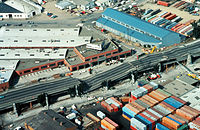
Photo from wikipedia
Giant rockslides are widespread and sensitive to hydrological forcing, especially in climate change scenarios. They creep slowly for centuries and then can fail catastrophically posing major threats to society. However,… Click to show full abstract
Giant rockslides are widespread and sensitive to hydrological forcing, especially in climate change scenarios. They creep slowly for centuries and then can fail catastrophically posing major threats to society. However, the mechanisms regulating the slow-to-fast transition toward their catastrophic collapse remain elusive. We couple laboratory experiments on natural rockslide shear zone material and in situ observations to provide a scale-independent demonstration that short-term pore fluid pressure variations originate a full spectrum of creep styles, modulated by slip-induced undrained conditions. Shear zones respond to pore pressure increments by impulsive acceleration and dilatancy, causing spontaneous deceleration followed by sustained steady-rate creep. Increasing pore pressure results in high creep rates and eventual collapse. Laboratory experiments quantitatively capture the in situ behavior of giant rockslides and lay physically-based foundations to understand the collapse of giant rockslides. Giant rockslides creep slowly for centuries and then can fail catastrophically, posing major threats to society. Here, the authors use observational and experimental evidence to quantitatively capture the full spectrum of giant rockslide behaviour until collapse, that is modulated by hydro-mechanical response to short-term fluid pressure perturbations.
Journal Title: Nature Communications
Year Published: 2020
Link to full text (if available)
Share on Social Media: Sign Up to like & get
recommendations!